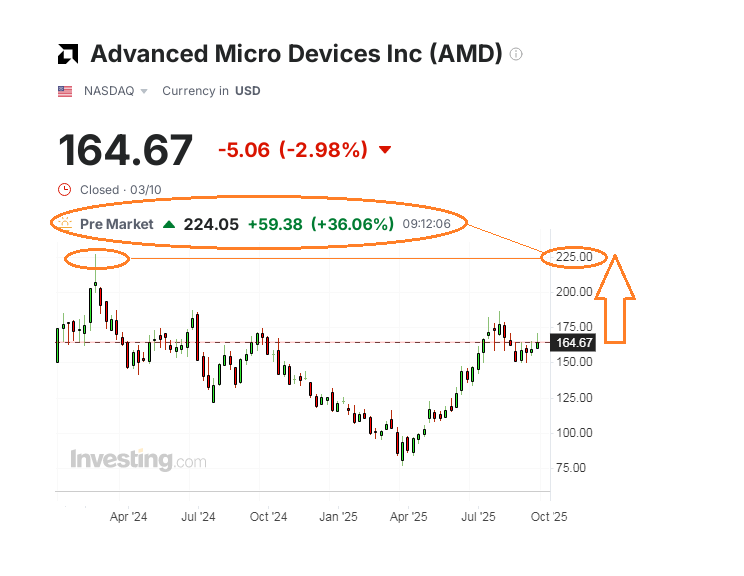Advanced Micro Devices, Inc. (NASDAQ)
- By date
- Metadoro first
Das ist fantastisch! They were only away a matter of minutes, perhaps no more than a quarter of an hour since this news began spreading around the wires, but AMD capitalization already soared by 36%. ChatGPT creators, OpenAI, want AMD chips for its ever-growing AI projects and even get an option to buy up to roughly 10% of AMD at the same time (160 million shares of AMD for 1 cent each over the course of this great deal). AMD stock, which was lagging from the AI industry's mainstream for so many months, immediately skyrocketed from nearly $165 at last week close to well above $225 at Monday pre-market. It's their highest level since very short-lived historical peaks in March 2024. Do you remember, when this asset was trading below $100 for a short time, I always told you that everything would be fine with AMD over time? But even I could not have imagined such a meteoric rise.
So, I am going to fix the major profit in my long-running AMD stake. I have a good reason to host some banquet function with champagne and delicious food today in the evening. Although AMD might soon cost $250, I don't care what happens next. They've already covered all realistic and unrealistic price targets in this upside step. I'll consider another cheaper AMD purchase later if the opportunity arises, or maybe even an expensive one, but after the market gets used to the higher price range for AMD stock.
Here's the whole point. A multi-year deal with OpenAI is supposed to bring "tens of billions of dollars" in AMD's annual revenue. OpenAI needs even more computing power in this limitless AI developing race, so that it now acquires a part of the second largest in the world GPU chips manufacturer after Nvidia. Thus, Open AI will get hundreds of thousands GPUs, equivalent to 6 gigawatts, while also giving a very strong vote of confidence to AMD shareholders. "We view this deal as certainly transformative, not just for AMD, but for the dynamics of the industry," AMD executive vice president Forrest "no-Gump" Norrod said. Because of the ripple effect, AMD expects to receive more than $100 billion of new income over next 4 years from OpenAI and other customers. The deal with AMD will help OpenAI build enough AI infrastructure to meet its needs, OpenAI CEO Sam Altman said. OpenAI would build a 1-gigawatt facility based on its forthcoming MI450 series of chips beginning next year, and it would begin to recognize revenue then.
Long before the OpenAI-AMD deal, Nvidia announced an investment of up to $100 billion in OpenAI that included a plan to supply at least 10 gigawatts worth of Nvidia systems. The plan included OpenAI deploying a gigawatt of Nvidia’s next-generation Vera Rubin chips in late 2026. But Altman shared his expectations of reaching as much as 250 gigawatts of computing in total by 2033. So, AMD is definitely not a kind of exclusive partner for Open AI, the deal doesn't change any of OpenAI’s ongoing computing plans, including its close partnership with Microsoft. But AMD is clearly not going to stay away from the AI progress, which many in the market were afraid of.

Advanced Micro Devices, Inc. (NASDAQ)
| Ticker | AMD |
| Contract value | 100 shares |
| Maximum leverage | 1:5 |
| Date | Short Swap (%) | Long Swap (%) | No data |
|---|
| Minimum transaction volume | 0.01 lot |
| Maximum transaction volume | 100 lots |
| Hedging margin | 50% |
| USD Exposure | Max Leverage Applied | Floating Margin |
|---|









